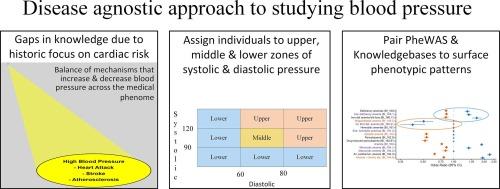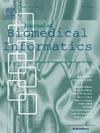解析高血压和慢性低血压的表型模式。
IF 4.5
2区 医学
Q2 COMPUTER SCIENCE, INTERDISCIPLINARY APPLICATIONS
引用次数: 0
摘要
目的:2017 年的血压(BP)分类侧重于心脏风险。我们假设,研究整个医学表型组中血压升高或降低机制之间的平衡将带来新的见解。我们设计了一种分类器,利用血压测量值将个体分配到以血压谱上区(Htn)、下区(Hotn)和中区(Naf)为中心的相互排斥的类别;并研究了这些血压类别的流行病学和表型模式:我们按血压类别对 832,560 份去标识化电子健康记录进行了分类;按性别和年龄段比较了血压类别以及 Htn 和 Hotn 四种亚型的频率;可视化了按血压类别分层的收缩压、舒张压、平均动脉压和脉搏压的分布;并对 Htn 和 Hotn 进行了全表型关联研究 (PheWAS)。我们将高血压和低血压知识库配对,并计算了表明已知关联的知识库总体状态(KB-status)。我们评估了PheWAS结果与知识库中嗜铬细胞编码的知识库状态的一致性,并将PheWAS相关性与知识库状态配对,以显示表型模式:血压类别代表了收缩压和舒张压多模态分布中的不同分布。它们以平均动脉压的上区、下区和中区为中心,提供与脉压不同的信号。对于知识库中的嗜铬细胞编码,85% 的正相关性与 KB 状态一致。Htn 和 Hotn 的表型模式在几个嗜铬细胞编码中重叠,而在其他编码中则分开。我们的分析为假设检验研究提出了五个候选方案,其中两个方案与 Htn 或 Hotn 的相关性可能未得到充分重视,三个方案中血压升高和降低的机制可能会影响彼此的表达:结论:PheWAS 成对方法可能为区分高血压和慢性低血压开辟了一条全表象之路。我们的分类器为将个体分配到代表血压谱上层、下层和中层区域的血压类别提供了一个起点。在符合 2017 年血压正常、血压升高或孤立性高血压类别的个体中,4.7% 的人有舒张压本文章由计算机程序翻译,如有差异,请以英文原文为准。

Disentangling the phenotypic patterns of hypertension and chronic hypotension
Objective
2017 blood pressure (BP) categories focus on cardiac risk. We hypothesize that studying the balance between mechanisms that increase or decrease BP across the medical phenome will lead to new insights. We devised a classifier that uses BP measures to assign individuals to mutually exclusive categories centered in the upper (Htn), lower (Hotn) and middle (Naf) zones of the BP spectrum; and examined the epidemiologic and phenotypic patterns of these BP-categories.
Methods
We classified a cohort of 832,560 deidentified electronic health records by BP-category; compared the frequency of BP-categories and four subtypes of Htn and Hotn by sex and age-decade; visualized the distributions of systolic, diastolic, mean arterial and pulse pressures stratified by BP-category; and ran Phenome-wide Association Studies (PheWAS) for Htn and Hotn. We paired knowledgebases for hypertension and hypotension and computed aggregate knowledgebase status (KB-status) indicating known associations. We assessed alignment of PheWAS results with KB-status for phecodes in the knowledgebase, and paired PheWAS correlations with KB-status to surface phenotypic patterns.
Results
BP-categories represent distinct distributions within the multimodal distributions of systolic and diastolic pressure. They are centered in the upper, lower, and middle zones of mean arterial pressure and provide a different signal than pulse pressure. For phecodes in the knowledgebase, 85% of positive correlations align with KB-status. Phenotypic patterns for Htn and Hotn overlap for several phecodes and are separate for others. Our analysis suggests five candidates for hypothesis testing research, two where the prevalence of the association with Htn or Hotn may be under appreciated, three where mechanisms that increase and decrease blood pressure may be affecting one another’s expression.
Conclusion
PairedPheWAS methods may open a phenome-wide path to disentangling hypertension and chronic hypotension. Our classifier provides a starting point for assigning individuals to BP-categories representing the upper, lower, and middle zones of the BP spectrum. 4.7 % of individuals matching 2017 BP categories for normal, elevated BP or isolated hypertension, have diastolic pressure < 60. Research is needed to fine-tune the classifier, provide external validation, evaluate the clinical significance of diastolic pressure < 60, and test the candidate hypotheses.
求助全文
通过发布文献求助,成功后即可免费获取论文全文。
去求助
来源期刊

Journal of Biomedical Informatics
医学-计算机:跨学科应用
CiteScore
8.90
自引率
6.70%
发文量
243
审稿时长
32 days
期刊介绍:
The Journal of Biomedical Informatics reflects a commitment to high-quality original research papers, reviews, and commentaries in the area of biomedical informatics methodology. Although we publish articles motivated by applications in the biomedical sciences (for example, clinical medicine, health care, population health, and translational bioinformatics), the journal emphasizes reports of new methodologies and techniques that have general applicability and that form the basis for the evolving science of biomedical informatics. Articles on medical devices; evaluations of implemented systems (including clinical trials of information technologies); or papers that provide insight into a biological process, a specific disease, or treatment options would generally be more suitable for publication in other venues. Papers on applications of signal processing and image analysis are often more suitable for biomedical engineering journals or other informatics journals, although we do publish papers that emphasize the information management and knowledge representation/modeling issues that arise in the storage and use of biological signals and images. System descriptions are welcome if they illustrate and substantiate the underlying methodology that is the principal focus of the report and an effort is made to address the generalizability and/or range of application of that methodology. Note also that, given the international nature of JBI, papers that deal with specific languages other than English, or with country-specific health systems or approaches, are acceptable for JBI only if they offer generalizable lessons that are relevant to the broad JBI readership, regardless of their country, language, culture, or health system.
 求助内容:
求助内容: 应助结果提醒方式:
应助结果提醒方式:


